Authors:
Juliette van Haren
One of the greatest concerns parents of extremely premature babies have is ensuring that their child receives the care needed to survive and develop. For these families the neonatal intensive care unit (NICU) becomes a vital space where specialized medical teams support their babies through the earliest and most vulnerable stages of human development using advanced technology. Emerging technologies continue to redefine neonatal care; one of the latest, though still in preclinical stages, is a liquid-based incubator with a placenta-like life support system [1]. A birth could unfold as follows: Following premature delivery around 24 weeks of pregnancy, the baby would be placed in a novel incubator and submerged in the fluid environment. The umbilical cord would be cut from the mother and connected to an artificial placenta, ensuring continued oxygen and nutrient supply. These artificial placenta and womb technologies are intended to extend organ development outside the mother's womb and could offer significant advances in reducing mortality and lifelong health consequences.
Beyond the technical and clinical implications, these disruptive innovations trigger fundamental questions about how to design such healthcare technologies in ways that account not only for short-term vital needs but also for long-term (cognitive) outcomes of the involved family [2]. How can we conduct user research for high-risk technologies in an open-minded and low-risk manner? How can we effectively engage stakeholders—preterm-born adults, parents, clinicians, ethicists, society—in the development of such advanced technological innovations? How can design research explore and shape the delicate balance between lifesaving interventions and the nurturing bonds critical to a child's development? There are many questions we need to ask ourselves before such technology can be brought to patients.
→ A future generation of liquid-based incubators for preterm infants, often called artificial wombs, is meant to extend fetal development.
→ Key topics related to long-term outcomes, parent-child interaction, family-centered care, ethics, legislation, and societal acceptance need to be investigated.
→ Low-risk medical simulation engages stakeholders to explore interaction possibilities and promotes value-sensitive design.
The HCI field may be well equipped to both identify experiential needs and shape parent-child interaction in life support technology. At the methodological level, approaches such as value-sensitive design and user/patient-centered design help ensure that the technology aligns with the values and needs of the stakeholders. By creating design probes and using methods such as design fiction, a more comprehensive collection and understanding of (tacit) experiential needs, design details, and functions can be established. Design principles such as multimodal interaction, multiuser interfaces, and ultrapersonalization can help establish user experiences that might not naturally evolve from medical and engineering research alone. On a material level, the integration of new interface materials and emergent technologies, such as noninvasive sensing, can enhance the functionality and usability of these life support systems. Previous human-computer interaction work within NICUs has argued for and demonstrated the significant complementary role that HCI designers and researchers can play in this clinical domain [3,4].
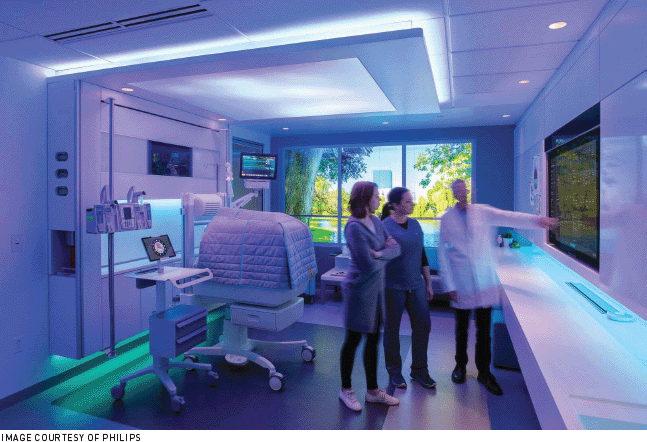 | Lotus: Next-generation neonatal intensive care unit from Philips. |
Critical to this discussion is the theme of parent-child bonding. Research shows that separation from the mother in the early days after birth can lead to insecure attachment, increasing the risk of mental disorders and affecting hormonal, epigenetic, and neuronaldevelopment [5]. The initial hours after birth are therefore critical for forming secure attachments, with early mother-child contact linked to better outcomes for both. Enhanced physical and emotional closeness supports the child's overall development and the mother's adjustment process to her new role.
The initial hours after birth are critical for forming secure attachments, with early mother-child contact linked to better outcomes for both.
The field of neonatology, the branch of pediatric medicine concerned with newborns, has evolved to emphasize parental involvement, integrating practices like kangaroo care (skin-to-skin contact) to support bonding and family well-being. Conventional incubators, initially designed for thermal care, have evolved into complex devices with integrated technologies for ventilation, medication, and monitoring. Although these incubators impose a physical barrier, they still allow some level of parent-infant interaction through touch, sound, or viewing. Despite the devices' basic design remaining constant, improvements have focused on reducing external stress and allowing parental involvement.
The standard-of-care guidelines for incubator components and neonatal ward design now emphasize family-centered care, with projects like Philips Healthcare's Wee Care and Lotus aiming to minimize disruptions. For example, the Lotus neonatal unit consists of a novel clinical informatics platform that integrates and visualizes data from all devices into a user-friendly interface, addressing clinicians' workflow and decision making while offering an adaptive healing environment that supports neuroprotective development and creates a calming atmosphere for families.
Multisensory-based interventions (auditory, vestibular, visual, kinesthetic, and olfactory and gustatory) have shown positive effects on health outcomes. Researchers have explored how systems may capture and replay sensory signals to mediate indirect contact between caregivers and infants. Let's take auditory interventions as an example. Several studies recorded maternal heartbeats, abdominal sounds, and voices using microphones or electronic stethoscopes, and then played them back to infants in incubators. Studies showed that exposure to sounds, or the lack thereof, can have a significant impact on outcomes.
Concepts developed in this area include the Mimo pillow and the Hugsy blanket, which capture and replay the maternal heartbeat for comfort [6,7]. During kangaroo care, the blanket records the mother's heartbeat and replays the sound once the baby is placed in the incubator. Additionally, Natus developed the Babybe, which features a gel mattress designed to mimic the mother's breathing movements, and a wearable device for the mother that can transmit her heartbeat and voice to her baby in real time when separated. These sensory-based interventions could support family well-being through mediated contact.
Reciprocal parent-child interaction must be reimagined in the context of these artificial womb technologies, where physical closeness to extremely premature infants may be even more limited. In contrast to current approaches in neonatal care, the artificial womb system acts as a physical barrier that inherently limits parent-infant contact. The barrier protecting the baby from outside hazards is also a barrier for interacting with parents. For the infant, being placed in a liquid-based incubator would mean that sensory contact with the mother, both parents, or healthcare professional is considerably restricted.
 Interactions in a Constructed Environment
Interactions in a Constructed Environment
Research into the design of incubator environments is crucial as environments literally shape us. Baby brains have a high degree of plasticity, and environmental influences can alter their structure and function [8]. We are living in constructed environments that shape our experiences and interactions, yet the impact of designed environments on well-being often isn't properly considered. This has been evident in the hospital room and incubator environment [9].
An artificial womb-like system, as well as a conventional incubator, can be considered an artificially constructed first home for extremely premature babies. It should be safe and nurturing—an environment for optimal development in which the infant can thrive. During human development in the womb, the sensory system depends heavily on natural stimuli for proper growth. The nervous system develops gradually, with tactile receptors in the skin the first to become active, followed by auditory, vestibular, visual, and gustatory and olfactory systems. Stimuli reaching the infant should not be hazardous, but complete sensory deprivation may also negatively affect development. Preterm babies miss out on crucial in-womb sensory stimulation during the third trimester, which is normally a key period for central nervous system development [10]. The challenge is to filter out hazardous stimuli and promote positive developmental stimuli. The intersection of neurobiology and design may be perfectly equipped to address these challenges in improving early sensorial experiences. The field of interaction design has the potential and the necessary knowledge to design for multisensory interactions, including those for parent-infant bonding. Due to the barrier between infants and the external environment physical interactions may need to be mediated and could include sensory substitution.
For a newborn, moving from the protective womb to the artificial setting of a neonatal intensive care unit is a significant transition. The womb has adapted and optimized for the best developmental environment through evolution, while the NICU only came into use during the late 19th century. Although incubators are lifesaving, sensorial intrusions in NICUs, such as intense lights and noise from alarms, disrupt biological rhythms and trigger stress reactions. It may well be that, from an interaction point of view, artificial womb technology, as well as the entire NICU environment, could provide a soft entry into the world for preterm infants. In the first weeks, it could mimic the womb closely in terms of external influences reaching the child, gradually increasing the permeability of this protective barrier to allow more interactions and eventually reaching the level of exposure found in a conventional incubator. In terms of parent-infant interaction, this may mean that during the initial weeks of treatment, bonding could resemble pregnancy-like bonding, while in the later weeks it would shift toward a more NICU-like bonding style.
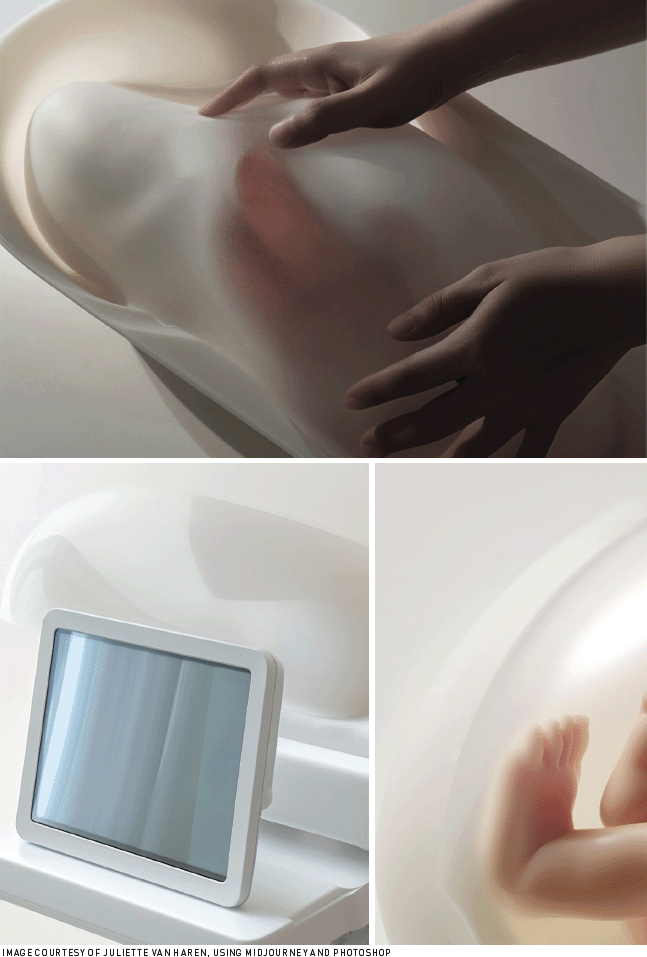 | Artistic impression of future parent-infant interactions in an artificial womb. |
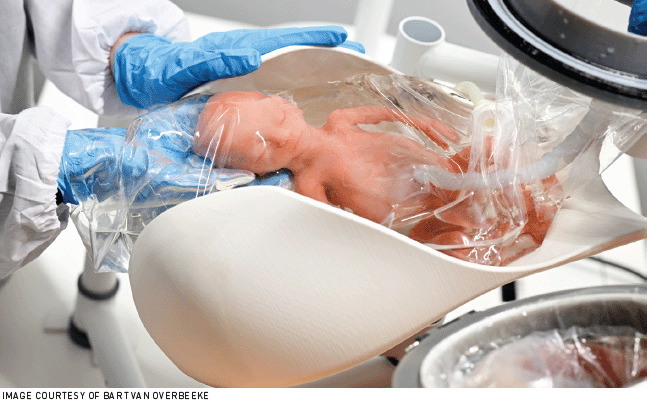 | Medical simulation of a novel birth procedure with a simulated extremely premature infant. |
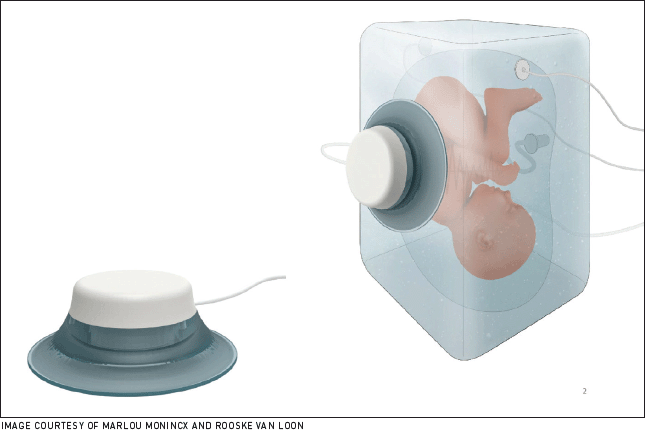 | The Womb phone, which uses a reciprocal auditory interaction. |
 Family-Centered Health Futures
Family-Centered Health Futures
The advancements in conventional incubators (and NICU) that support family-centered care should not be discarded with the introduction of next-generation liquid-based incubator models. The HCI field offers significant potential to improve family-centered care of preterm babies—from creating incubator interfaces for parent involvement in care routines to developing wearable devices for recording and simulating sensory signals and offering real-time feedback on the infant's condition. These design interventions can play a critical role in mitigating the stress associated with hospital stays and early separation, promoting a sense of connection and bonding that is crucial for emotional development.
Methodologies such as value-sensitive design should promote family-centered care innovation in this context. It helps prioritize and align the diverse values of stakeholders and promote responsible outcomes and technology acceptance by its intended user groups: parents, patient advocates, healthcare practitioners, and medical ethicists. What does it mean to design a system that optimally balances medical intervention with nurturing care? How can the design of such systems support—not hinder—parent-infant attachment and long-term health outcomes? By integrating the voices of all stakeholders, design can inject an early integrated consideration of affective needs and values into the generally more technology- and medicine-focused development.
Designing for preterm infants presents unique challenges. We cannot fully observe them in the natural environment of the womb, yet it is crucial to get it right the first time, before the first patient interacts with the system. Societal acceptance and ethical considerations demand an integrated approach to well-being, entailing more than just physiological health. So, how may we effectively engage a diverse range of stakeholders, explore interaction possibilities in a realistic setting, and ensure value-sensitive design when working with high-risk technologies?
Methods such as speculative fiction, design for debate, and vignette-based studies become essential tools. These approaches enable inclusive design by incorporating the concerns of preterm babies and their families into the technology development road map, far earlier than is typical in the introduction of new technologies.
When it comes to high-risk healthcare treatments involving life support technologies, particularly novel ones, ensuring safety and efficacy is difficult but crucial. While animal studies can provide initial validation, translating these technologies to human patients presents additional challenges. Medical simulation offers a promising approach for development and testing. Although medical simulation began as a tool for training healthcare professionals both in anatomical knowledge and skills, its scope has broadened. Today, it plays a crucial role in human factors engineering, aids in the collaborative design of surgical tools, and supports personalized treatment planning.
Our research group developed and explored the use of anatomically realistic patient simulators connected to computational models. The computational models are updated with real-time sensor data from the physical simulator to adapt the physiological condition of the infant and to predict the outcome of various physiological processes and clinical interventions. Biological responses are sent back to the patient simulator, triggering its embedded motors to simulate the responses to the procedure. This method allows for thorough evaluation and refinement of technology in a controlled environment before clinical application.
How do we go from theoretical speculative imagination to speculative enactment and tangible cocreation with stakeholders, while maintaining essential medical and technological requirements and building upon them? The key may lie in the idea expressed above. By anticipating potential healthcare futures and studying them with stakeholders "in action" in physical simulation studies, HCI design research can play a critical role in shaping these futures. By contributing earlier than usual in the technology development process, this approach allows for the integration of "softer" aspects. Ethically, this proactive stand is essential, as it helps ensure that the technology is used correctly the first time. Simulation is a useful tool to cocreate medical technologies and should extend beyond healthcare professionals to preterm-born adults, patient advocates, parents with preterm-born children, ethicists, and other stakeholders. It allows for a hands-on exploration of the potential tacit emotional and physical interactions within these emerging technologies, enabling a participatory, family-centered design process.
In life support technology, the boundary between biology and the artificial is tightly intertwined. The baby's constructed environment becomes integral to its overall experience, with its design determining which interactions are facilitated or restricted. By nature, this life support technology embodies HCI, despite the fact that clinical and engineering fields have received more attention. The HCI design field should contribute to this research, especially now, when the technology is still in its formative stage. Researchers and designers can contribute in the following areas:
- Multisensory HCI: Integrating growth-adaptive haptic, auditory, visual, and olfactory interactions to support neurodevelopment and parent-infant bonding, while ethically balancing automation with human (parent and clinician) input.
- Micro and macro environments: Considering both the immediate incubator environment and the broader NICU and addressing usability aspects such as peripheral feedback to minimize sensory overload.
- Family-centered care: Understanding and designing for the dynamics of access and separation between the infants and both professional caregivers and parents.
- Stakeholder engagement: Applying value-sensitive design and design fiction, and creating design probes, with tangible simulation supporting experiential value collection.
To better predict the impact of this intimate human-technology interaction, this article sheds light on the experiential needs of preterm care and argues for a collaborative, integrative, and hands-on approach to designing technologies for the very young. It calls for design frameworks that address potential future scenarios to redefine premature infant care and family-centered care, engaging stakeholders in conversations. With responsible innovation, we can ensure that lifesaving technologies align with broader societal and ethical values, contributing to health futures that, while technologically advanced, should above all be nurturing.
1. Kozlov, M. Human trials of artificial wombs could start soon. Here's what you need to know. Nature 621, 7979 (2023), 458–460, https://doi.org/10.1038/d41586-023-02901-1
2. Van der Hout-van der Jagt, M.B. et al. Interprofessional consensus regarding design requirements for liquid-based perinatal life support (PLS) technology. Frontiers in Pediatrics 9 (2022), 1–8; DOI:10.3389/fped.2021.793531
3. Rullo, A. The soft qualities of interaction. ACM Transactions on Computer-Human Interaction 15, 4 (2008); DOI:10.1145/1460355.1460359
4. Hauser, S., Suto, M.J., Holsti, L., Ranger, M., and MacLean, K.E. Designing and evaluating Calmer, a device for simulating maternal skin-to-skin holding for premature infants. Proc. of the 2020 CHI Conference on Human Factors in Computing Systems. ACM, 2020, 1–15; DOI:10.1145/3313831.3376539
5. Kommers, D., Oei, G., Chen, W., Feijs, L ., and Bambang-Oetomo, S. Suboptimal bonding impairs hormonal, epigenetic and neuronal development in preterm infants, but these impairments can be reversed. Acta Paediatrica 105, 7 (2016), 738–751; DOI:10.1111/apa.13254
6. Chen, W. et al. Mimo pillow—An intelligent cushion designed with maternal heartbeat vibrations for comforting newborn infants. IEEE Journal of Biomedical and Health Informatics 19, 3 (2015), 979–985; DOI:10.1109/JBHI.2014.2349153
7. Claes, S., Guerra, M.C., Du, J., Smits, L.M., Kommers, D., and Bambang-Oetomo, S.B. Hugsy: A comforting solution for preterm neonates designed to enhance parent-child bonding. 10th International Workshop on Cooperative and Human Aspects of Software Engineering. IEEE, 2017, 177–184; DOI:10.1109/CHASE.2017.26
8. Miguel, P.M., Pereira, L.O., Silveira, P.P., and Meaney, M.J. Early environmental influences on the development of children's brain structure and function. Developmental Medicine & Child Neurology 61, 10 (2019), 1127–1133; DOI:10.1111/dmcn.14182
9. White, R.D. The newborn intensive care unit environment of care: How we got here, where we're headed, and why. Seminars in Perinatology 35, 1 (2011), 2–7; DOI:10.1053/j.semperi.2010.10.002
10. Di Fiore, J.M., Liu, G., Loparo, K.A., and Bearer, C.F. The effect of early postnatal auditory stimulation on outcomes in preterm infants. Pediatric Research 96, 6 (2024); DOI:10.1038/s41390-024-03329-7
Juliette van Haren is an assistant professor in the Department of Industrial Design at Eindhoven University of Technology. Her background is in (neuro)biology and industrial design, and she explores the intersection of technology, design, and biology in her research. [email protected]
 This work is licensed under Creative Commons Attribution-NoDerivs International 4.0.
This work is licensed under Creative Commons Attribution-NoDerivs International 4.0.
The Digital Library is published by the Association for Computing Machinery. Copyright © 2025 ACM, Inc.
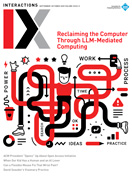
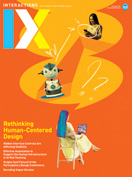
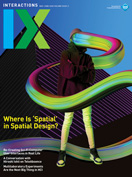
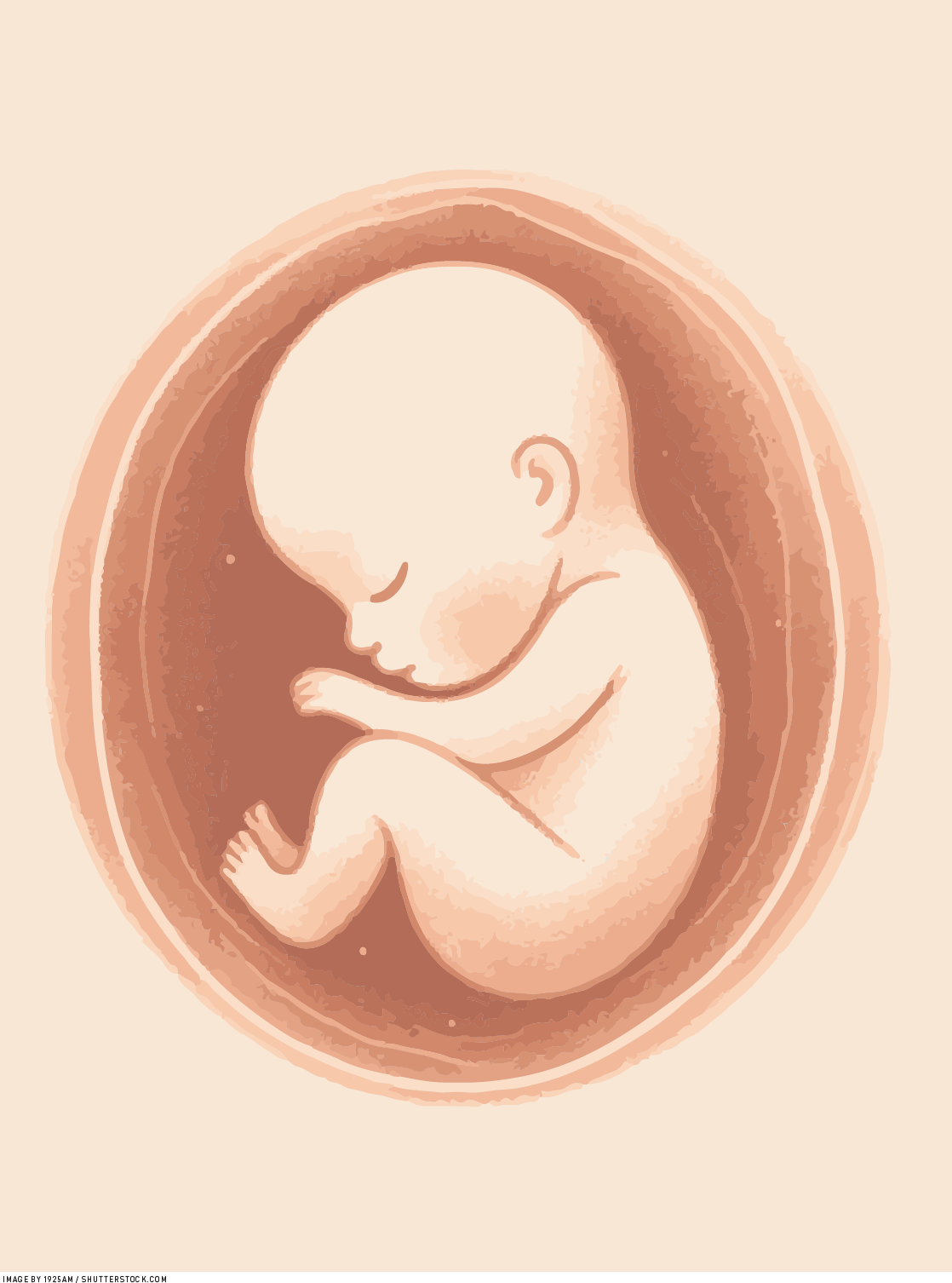



Post Comment
No Comments Found